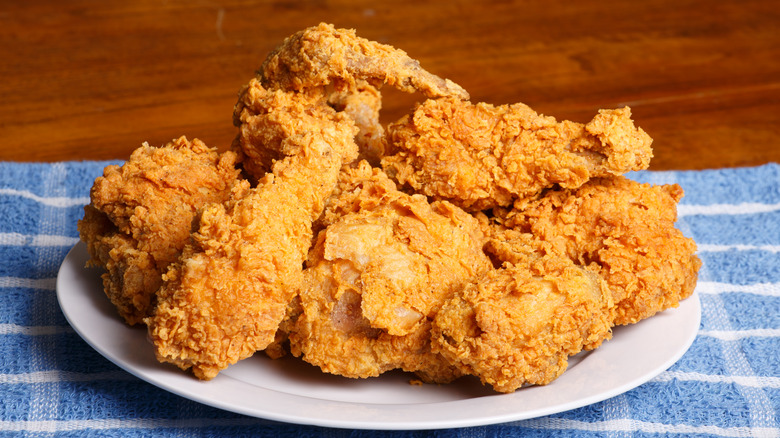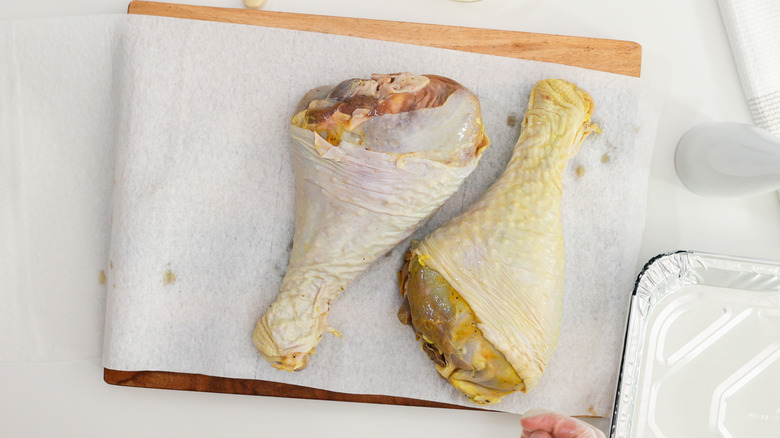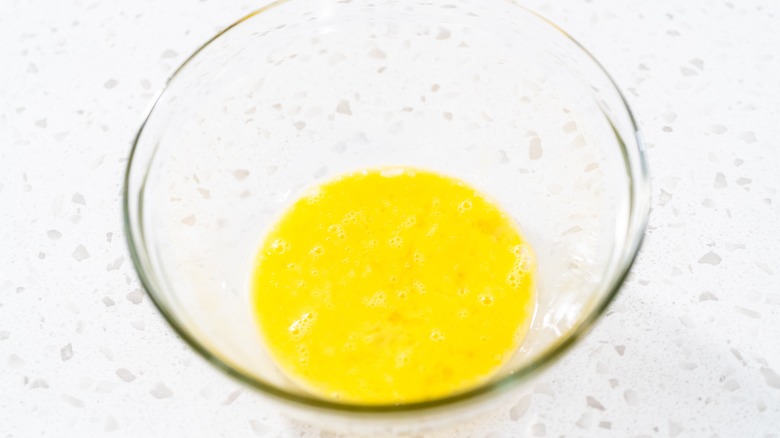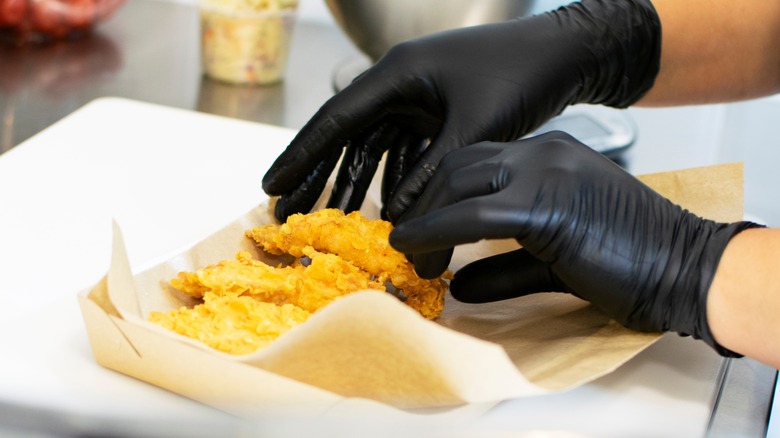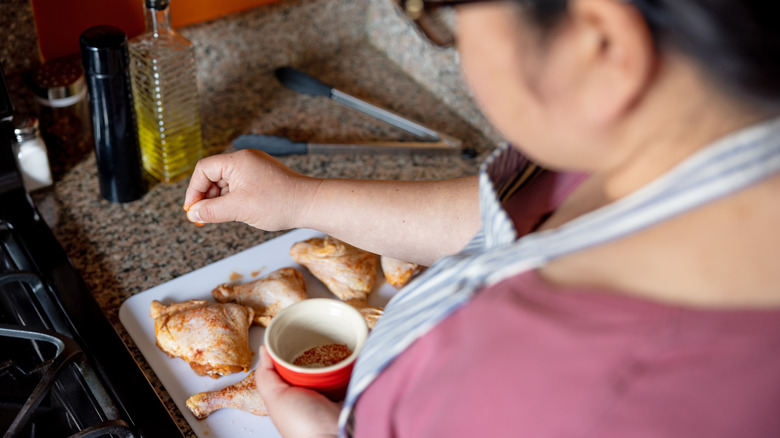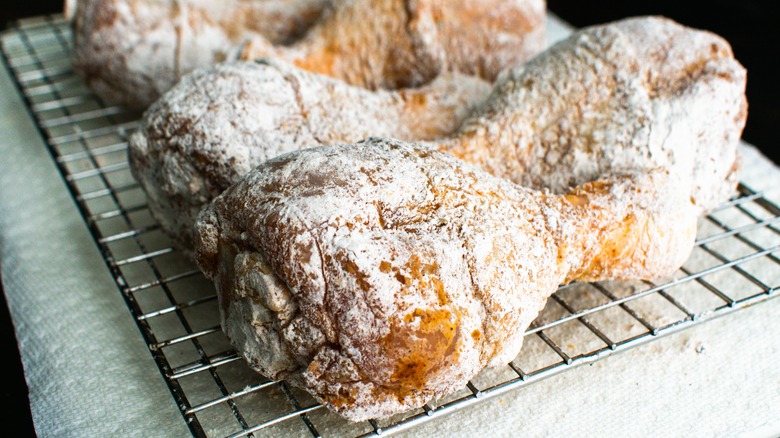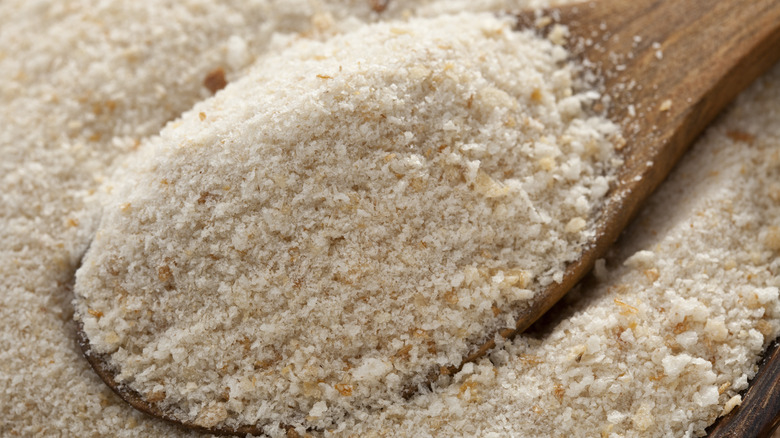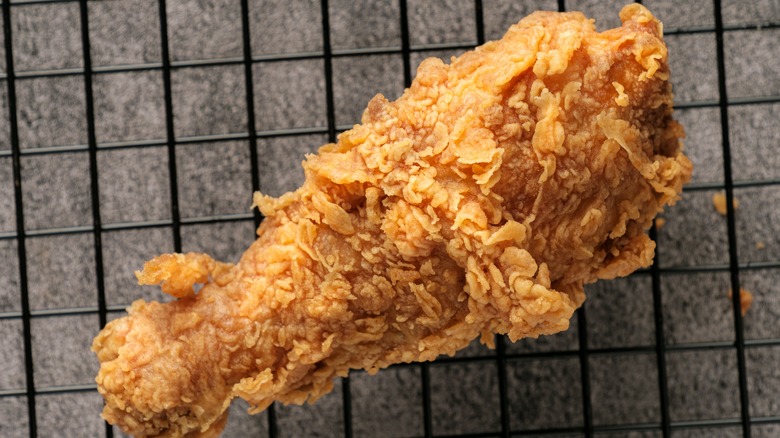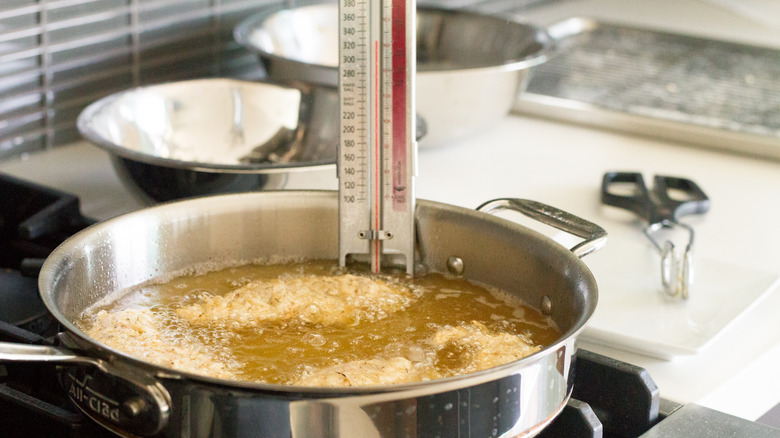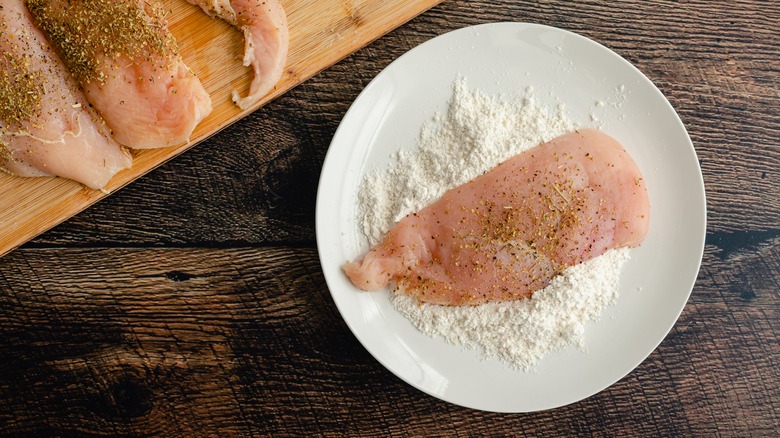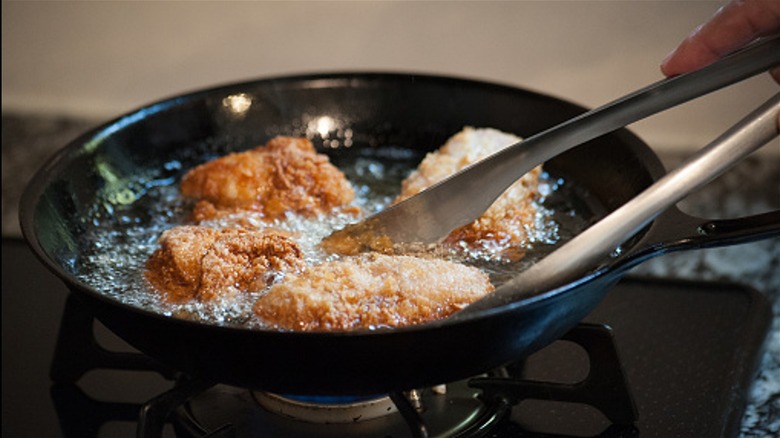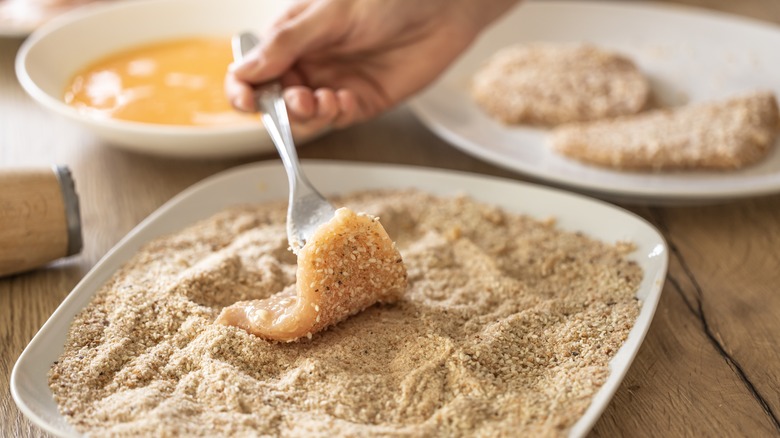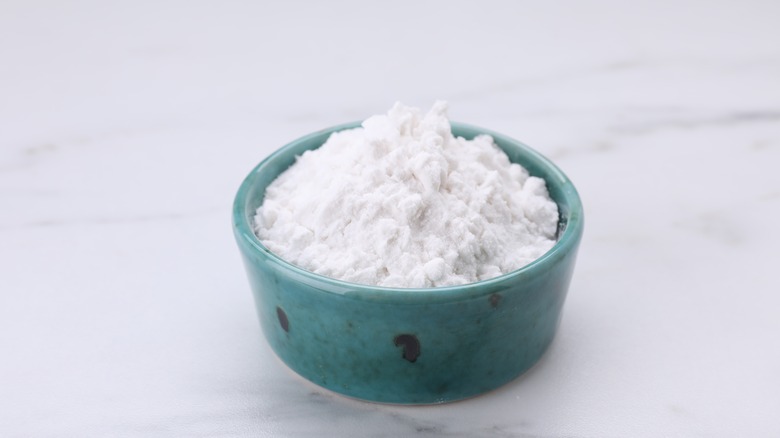Experts Reveal The Breading Mistakes That Are Ruining Your Fried Chicken
Breading fried chicken is relatively easy, isn't it? After all, all there is to it is adding a coating of breadcrumbs or flour to cutlets, drumsticks, or other pieces ... how hard could that actually be? As it turns out, there are quite a few missteps to make. Luckily, there are also quite a few tips and tricks out there that can help ensure your breaded fried chicken comes out as deliciously as you intended. Failing to follow the right protocol when breading fried chicken could lead to disastrous results, but don't worry, as we aim to help fix all of that.
We pulled out all of the stops by consulting head chefs and other experts in the food industry to help clue you in on the most common breading mistakes that are poised to ruin your fried chicken. From explaining how to avoid issues from bland and flavorless mixes to breading that's been burnt to an unappetizing crisp, our experts are here to show you a thing or two about how to achieve that perfect crunch you're going for. They're ready to dish on the most common breading mistakes people make that tend to ruin fried chicken.
Not drying the chicken first
It may be tempting to do, especially when you're in a hurry, but forgetting to dry your chicken could end up costing you when it comes to achieving the perfect breading on fried chicken. As Chef Rena Awada of Healthy Fitness Meals tells us, drying the chicken before you cook is perhaps more important than you realize. "If the chicken is too wet, the breading won't stick to it properly," explains Awada. Not only will wet chicken keep the breading from adhering to the meat, but it can dramatically affect the texture. According to chef Jessica Randhawa of The Forked Spoon, "Moisture is the enemy of a crisp coating because it can cause the breading to become soggy."
Instead of attempting to bread wet chicken, experts recommend you simply blot dry your chicken with paper towels. The paper towels will remove excess moisture and also make for easy clean up. As always, be sure to wash your hands, sanitize any surfaces your chicken has come into contact with during your prep time, and be sure to place your blotting towels directly in the trash after use. And, no, you really don't need to wash raw chicken beforehand, as that can spread germs across your kitchen.
Not using enough egg wash
Using an egg wash may seem like another unnecessary step when attempting to bread fried chicken, but in all honesty, it's a significant phase in the process that can lead to perfectly crispy fried chicken. Our experts caution that omitting the egg wash may result in the breading failing to adhere. Then again, using too much egg wash can be equally ineffective. To achieve the best results, you'll need to strike the right balance. "Don't be stingy and try to skimp on the egg wash," says Awada. "Not using enough egg wash will make the breading fall off. You need to make sure that the chicken is thoroughly coated in the egg mixture so the breadcrumbs stick better. Alternatively, too much egg wash will cause the breading to be too soggy."
Thankfully, an egg wash isn't rocket science and can be whipped up quickly before you even begin frying your chicken. To make an egg wash, Ken Tobby, B.Sc. in Food Science and Agroprocessing and owner of Organic Solace recommends you grab an egg or two along with a bit of liquid, "Beat the eggs with a small amount of water or milk," he says. "Adding hot sauce or additional seasonings to the egg wash can enhance the flavor." You'll then dip your chicken in the wash before dredging it in the flour ... unless of course, you plan to double dredge your meat. More on that later!
Not pressing the breadcrumbs
When breading fried chicken, there are some steps that require time, effort, and ingredients, while others simply require attention to detail. This is one of those detail-oriented processes. Pressing breadcrumbs into your chicken pieces might not seem like a big deal, especially when you've already gotten the surface of the chicken dry and dipped it in an egg wash. Nevertheless, our experts assert that pressing your breadcrumbs into the chicken skin is vital if you expect your breading to stay in place. "If you simply dip the chicken into the breadcrumbs without pressing it down gently, the breading won't stick," explains Awada.
Of course, this applies only if you are using breadcrumbs or a similar coating in the first place. If you are simply using flour to coat your fried chicken, this might not be necessary. Just know that fried chicken coated in plain flour as opposed to breadcrumbs will yield varying results in crispiness. Ultimately, if crunchy breadcrumb-style fried chicken is your goal, then going the breadcrumb route and pressing that into the skin of your chicken is a pro tip you won't want to skip.
Skipping the seasoning
We'd like to think that most of you already know this one, but it's such an important step that it bears repeating: seasonings are important! "I highly recommend you not skip adding seasonings to your breadcrumbs or flour; otherwise, you will end up with bland breaded chicken," Awada states. "Use those seasonings! It adds so much flavor."
Not sure what to use? While salt and pepper will do just fine, Tobby spices things us a bit by filling us in on a few other delicious options that will get your fried chicken breading tasting that much better. "Combine all-purpose flour and your favorite seasonings in a big bowl," he says. "Common choices include black pepper, garlic powder, paprika, onion powder, salt, and cayenne pepper." From there, you can pat your chicken dry, use your egg wash, and dredge your chicken pieces in that deliciously spiced flour to get the flavor you've dreamed of.
Note also that it isn't only the breading that can make for a great meal. Using buttermilk for fried chicken brine can give it a serious flavor boost as well. "Give the chicken a minimum of one hour or overnight marinating time in buttermilk," Tobby instructs. "Buttermilk tenderizes the meat and helps the breading stick. To give the buttermilk more flavor, add pepper, salt, and other flavors."
Not allowing breaded chicken to rest before frying
When it comes to frying chicken or cooking any type of meat really, it is important to rest your meat after it's been cooked. Interestingly, our experts recommend that you not only rest your meat after cooking but prior to cooking as well. "After breading your chicken, let it sit for a few minutes before frying," suggests Randhawa. "This waiting period helps the coating adhere to the chicken better and prevents it from flaking off when you start to cook it."
Like so many of the other tips, this is a very simple step that doesn't require you to do anything special, apart from wait. Still, though it isn't hard to let your chicken rest before cooking, it may try your patience, especially if you're feeling quite hungry. Expert recommendations for just how long you should let your chicken sit prior to cooking varies. While Awada says about 10-15 minutes will do the trick, Tobby suggests waiting a bit longer at 15-20 minutes. Either way, experts agree that this is a must for producing truly good breaded fried chicken.
Not using the right breadcrumbs
When frying up a good batch of fried chicken it's all about the crunch, right? Yet our experts warn that using any old breadcrumbs simply won't do.
There's a method to the madness when it comes to selecting the right breadcrumbs for frying chicken, and no, not all breadcrumbs are on an equal playing field. According to Awada, "Panko breadcrumbs make the breading crunchier than traditional breadcrumbs." Panko breadcrumbs are a Japanese-style breadcrumb that comes from white bread without the crust, meaning they won't absorb as much water as other varieties. As a result, panko breadcrumbs will be more likely to get you that satisfyingly tasty crunch you so desire, and to do so faster than other types of breadcrumbs that are typically sold in stores.
In addition, Awada issues a warning about the freshness of breadcrumbs: "Do not use stale breadcrumbs! If you use stale breadcrumbs, you will end up with a less crunchy and flavorful breading." Point taken!
Forgetting to drain excess oil
Draining oil on chicken is necessary after frying, but, contrary to what you may believe, draining excess oil on chicken is a bit of a science. That's especially true since common methods may actually be counterintuitive and could even work to make your breading less crispy. Tobby let us know that a wire rack is really the best way to go when draining excess oil from fried chicken, but you should avoid paper towels. As Tobby tells us, "Paper towels should not be used since they can trap steam and cause the coating to get wet."
In addition, Awada warns about the dangers of transferring breaded fried chicken directly to a plate after frying. "Do not place freshly fried chicken directly on a plate. This can make the bottom of your breaded chicken soggy," she says. Instead, she also recommends you place the fried breaded chicken on a wire rack and let it drain over a baking sheet. "This will keep your breaded chicken crispy," she explains.
Not keeping an eye on oil temperature
Oil temperature is yet another huge factor in frying chicken. Believe it or not, even seemingly small differences in temperature can really make or break your breaded fried chicken. Many of the experts we spoke to recommended keeping a close eye on oil temperature to achieve perfectly fried breaded chicken. "Heat your oil to the right temperature, typically between 350-375 degrees Fahrenheit (175-190 degrees Celsius)," Randhawa explains. But why does it matter so much? "If the oil is too hot, the breading will burn before the chicken cooks through. If it's too cool, the chicken will absorb the oil, becoming greasy."
At this point, you may be wondering how exactly you might go about checking and maintaining oil temperature between 350-375 degrees Fahrenheit. The trick is rather simple: use a thermometer as you fry your chicken. One that clips tot he side of the pan, such as a deep frying or candy thermometer, is ideal. This allows for greater precision and a better understanding of what's happening. "I recommend using a thermometer to maintain the temperature of the oil," Randhawa says, "because the oil temperature can fluctuate during frying. Keep an eye on the thermometer and adjust the heat when needed." By doing this, you'll more easily maintain a steady temperature, which helps to ensure more even cooking and prevents burning.
Not double dredging
Double dredging may at first sound unnecessary and, indeed, if you like a thinner coating on your fried chicken, this tip may not be for you. For the rest of us, however, a nice, thick, crunchy coating sounds mouthwateringly delicious, but it doesn't happen by accident. As usual, our cooking experts have the secrets you didn't know you needed when it comes to achieving that crispy crunch reminiscent of your grandma's finger-licking fried chicken recipe. Here, it's all about doubling up.
"If you want an extra crispy coating, do not skip the step[s] of dredging the chicken in flour, then egg wash, and then back in the flour or breadcrumbs," says Awada. "This will result in a thicker and crunchier crust." Tobby agrees, citing that following these steps in order will lead to an extra crispy and thicker fried chicken coating.
Not a fan of the mess? Remember that wire racks are your friend here. Once you've coated your chicken in flour the first time, you can allow the pieces to rest on a wire rack as you finish coating the others. After you dunk your chicken into the egg wash and back into the flour, allow them to sit again on the wire rack (allowing them to rest, remember?) before you start cooking. Oh, and don't forget about the buttermilk we told you about earlier. Allowing your chicken. to marinate in it before double dredging will make your extra crispy chicken that much juicier.
Overcrowding the pan
Your grandmother probably taught you that overcrowding the pan is a major no-no in the world of cooking, and to be honest, grandma is right. Overcrowding your fried chicken leads to unsavory consequences in terms of how the breading on your chicken will turn out, and our experts are here to share just what makes this mistake such a culinary faux pas. "Adding too many pieces of chicken to the oil at once will lower the temperature of the oil, leading to soggy breading," explains Awada. "I recommend working in batches to maintain the oil temperature and get the best crisp coating." Though frying in batches can be a drag, especially when hungry, Randhawa signs off on this method, promising that doing so will lead to optimal results. "[Not overcrowding the pan] ensures that each piece cooks evenly and stays as crisp as possible," she says.
So, just how many pieces of chicken at once should you fry? There isn't really any set rule, although from what we read, an inch or two between pieces will likely suffice. Yes, it will take a while longer before it'll be ready plate up, but the juicy and crispy results will be well-worth it in the end.
Not using a good system
Using a three-station breading setup can set you up for success — quite literally. We've already talked about the double dredge method and how important it is to getting great results, but keeping yourself organized with a more structured system will really help the breading process to go smoothly. To achieve that, Tobby says that it's pretty simple. "Arrange three shallow dishes: one with seasoned flour, one with egg wash, and one with additional seasoned flour or breadcrumbs for a final coat," he says. Set up this organized system next to the area where you plan to fry your chicken for a faster and more efficient (and hopefully less messy) process.
To this three-station breading setup, you also will want to add a fourth component: those wire racks we mentioned earlier. Simply set up your wire racks in an area where your chicken can safely drain after cooking (ideally, somewhere near the cooking station for less mess and ease of transport) and you'll have a fried chicken system that can help you to achieve a perfect outcome.
Not adding cornstarch to your flour
Did you know that adding cornstarch to flour when frying chicken is "a thing"? We didn't. But according to Tobby, this is one surefire way to achieve the fried chicken of your dreams — if you love an extra crispy coating, that is.
Adding a bit of cornstarch to flour really helps take fried chicken over the edge in terms of crispy-crunchy deliciousness. Not sure where to start? As Tobby explains, a little goes a long way. "A ratio of one part cornstarch to four parts flour works well," he states.
While we're on the subject, we want you to know that there's another unsuspecting ingredient in your pantry that also lends itself to a crispier and crunchier fried chicken: baking powder. You may even consider blending both baking powder and cornstarch in your flour for the ultimate crunch. Hey, it may sound a bit strange, but according to our experts, these kitchen staples work wonders when it comes to producing crispy fried chicken breading. You're welcome!
